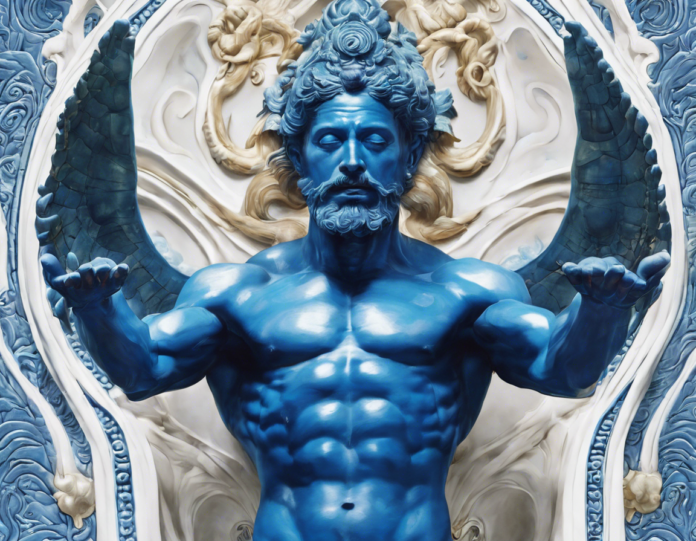In Hindu mythology, there are numerous deities each embodying different attributes and symbolism. One of the most beloved and prominent deities in Hinduism is Lord Krishna. Known for his playfulness, wisdom, and divine love, Krishna’s stories and teachings are cherished by millions of devotees around the world. Let’s dive into the mystical world of this Blue God and explore the various aspects that make him such a revered figure in Hinduism.
Origins and Background
Lord Krishna is believed to be the eighth incarnation of Lord Vishnu, one of the principal deities in Hinduism. He is said to have descended to Earth to uphold the principles of dharma and to protect the righteous. Born in the Dwapara Yuga on the ashtami (eighth day) of the Krishna Paksha (dark fortnight) in the month of Bhadrapada, Krishna’s birth is celebrated as Janmashtami, one of the most significant festivals in Hindu culture.
Krishna’s early life is filled with fascinating stories, from his childhood antics in Vrindavan to his role as a charioteer and advisor in the epic battle of the Mahabharata. His teachings to Arjuna on the battlefield, as captured in the sacred text of the Bhagavad Gita, continue to inspire spiritual seekers and philosophers worldwide.
The Blue Complexion
One of the most distinguishing features of Krishna is his blue complexion. The reason behind his blue skin has both symbolic and mythological significance. According to Hindu mythology, Krishna’s skin is blue due to a divine curse. Once, while playing with his friends, Krishna ingested soil, which angered his mother, Yashoda. In a playful punishment, Yashoda tied Krishna to a mortar. As a result of this incident, Krishna’s skin turned blue.
Symbolically, the color blue represents the infinite and the divine. Blue is the color of the sky and the ocean, both of which are vast and eternal. Krishna’s blue complexion signifies his unlimited and transcendental nature. It is a reminder that he is not bound by earthly limitations but is a supreme being beyond human understanding.
Key Teachings and Philosophy
Krishna’s teachings, as outlined in the Bhagavad Gita, cover a wide range of philosophical concepts and spiritual truths. Some of the key teachings of Krishna include:
1. Dharma and Duty
Krishna emphasizes the importance of fulfilling one’s duty (dharma) without attachment to the results of actions. He teaches that one should perform their duties to the best of their abilities without getting entangled in desires and expectations.
2. Detachment and Renunciation
Krishna advocates for detachment from the material world and renunciation of selfish desires. He encourages his followers to live a life of selflessness and dedication to a higher cause.
3. Devotion and Love
Krishna extols the virtues of devotion (bhakti) and unconditional love for the divine. He teaches that true fulfillment and liberation come through surrendering to the supreme power with love and devotion.
4. Oneness and Unity
Krishna emphasizes the oneness of all beings and the underlying unity of creation. He teaches that diversity is an expression of the divine and that love and compassion should guide all actions.
Depictions and Symbols
Krishna is often depicted in various forms and poses in Hindu iconography. Some of the popular depictions and symbols associated with Lord Krishna include:
1. Flute (Murali): Krishna is often depicted playing the flute, symbolizing his divine melody that attracts devotees towards him.
2. Peacock Feather: The peacock feather adorning Krishna’s crown represents beauty and grace. It is also a symbol of protection.
3. Cow (Kamadhenu): Krishna’s fondness for cows and his role as a cowherd in Vrindavan symbolize nurturing and protection.
4. Lotus: The lotus flower, often associated with purity and enlightenment, is another symbol commonly linked with Krishna.
Worship and Festivals
Devotees of Lord Krishna engage in various forms of worship to express their love and devotion towards him. Bhakti yoga, the path of devotion, is a popular way to connect with Krishna on a personal level. Singing bhajans (devotional songs), chanting mantras such as the Hare Krishna Maha Mantra, and performing aarti (ritual of worship) are common practices among Krishna devotees.
Apart from daily worship, there are several festivals dedicated to Lord Krishna celebrated with great fervor by his followers. Some of the major Krishna festivals include:
1. Janmashtami: The birthday of Lord Krishna, celebrated with fasting, devotional songs, and reenactments of Krishna’s life events.
2. Holi: The festival of colors, where devotees commemorate the playful antics of Krishna and Radha by smearing each other with colored powders.
3. Govardhan Puja: A festival that honors Govardhan Hill, which Krishna lifted on his finger to protect the villagers from the wrath of Lord Indra.
4. Radhashtami: Celebrates the appearance day of Radha, Krishna’s divine consort, and exemplifies the divine love between Radha and Krishna.
FAQs (Frequently Asked Questions)
1. Why is Krishna depicted with a flute?
Krishna playing the flute symbolizes divine harmony and the call of the soul. The sound of Krishna’s flute is said to attract devotees and fill their hearts with love and devotion.
2. What is the significance of Krishna’s peacock feather?
The peacock feather worn by Krishna represents beauty, grace, and protection. It is a symbol of Krishna’s supreme elegance and his connection to nature.
3. Why is Krishna often depicted as a cowherd?
Krishna’s role as a cowherd in Vrindavan symbolizes his nurturing and protective nature towards all beings. The cow is considered sacred in Hinduism, and Krishna’s affinity for cows highlights his compassion and love for creation.
4. What is the Hare Krishna Maha Mantra?
The Hare Krishna Maha Mantra, also known as the Great or Hare Krishna Mantra, is a chant that glorifies Krishna and Radha. It is believed to bring divine blessings and spiritual elevation to the chanter.
5. How can one cultivate devotion to Lord Krishna?
Devotion to Lord Krishna can be cultivated through practices such as chanting, meditation, service to others, studying his teachings, and immersing oneself in his divine pastimes. Developing a loving relationship with Krishna and surrendering to his will is key to deepening one’s devotion.
In conclusion, Lord Krishna stands as a beacon of wisdom, compassion, and unconditional love in Hindu mythology. His teachings continue to inspire countless individuals on their spiritual journey towards self-realization and divine connection. By understanding the mythic and symbolic significance of Krishna’s persona and teachings, one can embark on a path of transformation and enlightenment guided by the timeless wisdom of the Blue God.


